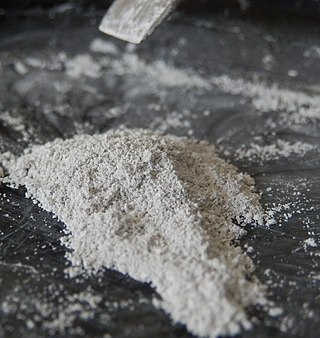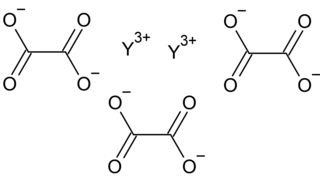Related Research Articles

In chemistry, a salt or ionic compound is a chemical compound consisting of an ionic assembly of positively charged cations and negatively charged anions, which results in a neutral compound with no net electric charge. The constituent ions are held together by electrostatic forces termed ionic bonds.

In chemistry, Ferric refers to the element iron in its +3 oxidation state. Ferric chloride is an alternative name for iron(III) chloride (FeCl3). The adjective ferrous is used instead for iron(II) salts, containing the cation Fe2+. The word ferric is derived from the Latin word ferrum, meaning "iron".

Thiocyanates are salts containing the thiocyanate anion [SCN]−. [SCN]− is the conjugate base of thiocyanic acid. Common salts include the colourless salts potassium thiocyanate and sodium thiocyanate. Mercury(II) thiocyanate was formerly used in pyrotechnics.
Classical qualitative inorganic analysis is a method of analytical chemistry which seeks to find the elemental composition of inorganic compounds. It is mainly focused on detecting ions in an aqueous solution, therefore materials in other forms may need to be brought to this state before using standard methods. The solution is then treated with various reagents to test for reactions characteristic of certain ions, which may cause color change, precipitation and other visible changes.

Iron(II) hydroxide or ferrous hydroxide is an inorganic compound with the formula Fe(OH)2. It is produced when iron(II) salts, from a compound such as iron(II) sulfate, are treated with hydroxide ions. Iron(II) hydroxide is a white solid, but even traces of oxygen impart a greenish tinge. The air-oxidised solid is sometimes known as "green rust".
In chemical nomenclature, the IUPAC nomenclature of inorganic chemistry is a systematic method of naming inorganic chemical compounds, as recommended by the International Union of Pure and Applied Chemistry (IUPAC). It is published in Nomenclature of Inorganic Chemistry. Ideally, every inorganic compound should have a name from which an unambiguous formula can be determined. There is also an IUPAC nomenclature of organic chemistry.

Mercury(II) thiocyanate (Hg(SCN)2) is an inorganic chemical compound, the coordination complex of Hg2+ and the thiocyanate anion. It is a white powder. It will produce a large, winding "snake" when ignited, an effect known as the Pharaoh's serpent.

Sodium thiocyanate (sometimes called sodium sulphocyanide) is the chemical compound with the formula NaSCN. This colorless deliquescent salt is one of the main sources of the thiocyanate anion. As such, it is used as a precursor for the synthesis of pharmaceuticals and other specialty chemicals. Thiocyanate salts are typically prepared by the reaction of cyanide with elemental sulfur:
Iron shows the characteristic chemical properties of the transition metals, namely the ability to form variable oxidation states differing by steps of one and a very large coordination and organometallic chemistry: indeed, it was the discovery of an iron compound, ferrocene, that revolutionalized the latter field in the 1950s. Iron is sometimes considered as a prototype for the entire block of transition metals, due to its abundance and the immense role it has played in the technological progress of humanity. Its 26 electrons are arranged in the configuration [Ar]3d64s2, of which the 3d and 4s electrons are relatively close in energy, and thus it can lose a variable number of electrons and there is no clear point where further ionization becomes unprofitable.

Potassium ferrioxalate, also called potassium trisoxalatoferrate or potassium tris(oxalato)ferrate(III) is a chemical compound with the formula K3[Fe(C2O4)3]. It often occurs as the trihydrate K3[Fe(C2O4)3]·3H2O. Both are crystalline compounds, lime green in colour.

Cobalt(II) thiocyanate is an inorganic compound with the formula Co(SCN)2. The anhydrous compound is a coordination polymer with a layered structure. The trihydrate, Co(SCN)2(H2O)3, is a isothiocyanate complex used in the cobalt thiocyanate test (or Scott test) for detecting cocaine. The test has been responsible for widespread false positives and false convictions.
In analytical chemistry, argentometry is a type of titration involving the silver(I) ion. Typically, it is used to determine the amount of chloride present in a sample. The sample solution is titrated against a solution of silver nitrate of known concentration. Chloride ions react with silver(I) ions to give the insoluble silver chloride:

Ferrous oxalate (iron(II) oxalate) are inorganic compound with the formula FeC2O4(H2O)x where x is 0 or 2. These are orange compounds, poorly soluble in water.

Copper(I) thiocyanate is a coordination polymer with formula CuSCN. It is an air-stable, white solid used as a precursor for the preparation of other thiocyanate salts.

Yttrium oxalate is an inorganic compound, a salt of yttrium and oxalic acid with the chemical formula Y2(C2O4)3. The compound does not dissolve in water and forms crystalline hydrates—colorless crystals.

Organic thiocyanates are organic compounds containing the functional group RSCN. the organic group is attached to sulfur: R−S−C≡N has a S–C single bond and a C≡N triple bond.

Neodymium compounds are compounds formed by the lanthanide metal neodymium (Nd). In these compounds, neodymium generally exhibits the +3 oxidation state, such as NdCl3, Nd2(SO4)3 and Nd(CH3COO)3. Compounds with neodymium in the +2 oxidation state are also known, such as NdCl2 and NdI2. Some neodymium compounds have colors that vary based upon the type of lighting.
Francium compounds are compounds containing the element francium (Fr). Due to francium being very unstable, its salts are only known to a small extent. Francium coprecipitates with several caesium salts, such as caesium perchlorate, which results in small amounts of francium perchlorate. This coprecipitation can be used to isolate francium, by adapting the radiocaesium coprecipitation method of Lawrence E. Glendenin and C. M. Nelson. It will additionally coprecipitate with many other caesium salts, including the iodate, the picrate, the tartrate, the chloroplatinate, and the silicotungstate. It also coprecipitates with silicotungstic acid, and with perchloric acid, without another alkali metal as a carrier, which leads to other methods of separation.
Transition metal complexes of thiocyanate describes coordination complexes containing one or more thiocyanate (SCN-) ligands. The topic also includes transition metal complexes of isothiocyanate. These complexes have few applications but played significant role in the development of coordination chemistry.
References
- 1 2 J. A. Allen (1953). "The Precipitation of Nickel Oxalate". J. Phys. Chem. 57 (7): 715–716. doi:10.1021/j150508a027.
- ↑ "Solubility Table". intro.chem.okstate.edu.
- ↑ M. J. Joyce; F. Ninio (1989). "Raman Spectrum of Rubidium Thiocyanate at 37 K and Room Temperature". Australian Journal of Physics. 42 (4): 389–400. doi: 10.1071/PH890389 .
- ↑ Birgitta Carell; Åke Olin (1961). "Studies on the Hydrolysis of Metal Ions. 37. Application of the Self-Medium Method to the Hydrolysis of Beryllium Perchlorate". Acta Chemica Scandinavica. 15: 1875–1884. doi: 10.3891/acta.chem.scand.15-1875 .
- ↑ W. J. Biermann; R. H. McCorkell (1967). "Liquid–liquid extraction of beryllium thiocyanate". Canadian Journal of Chemistry. 45 (22): 2846–2849. doi: 10.1139/v67-459 .
- ↑ K. Mereiter; A. Preisinger (1982). "Structure of magnesium isothiocyanate tetrahydrate". Acta Crystallographica B. 38: 1263–1265. doi:10.1107/S0567740882005433.
- ↑ Claudia Wickleder; Patrick Larsen (2002). "Ca(SCN)2 and Ca(SCN)2 · 2 H2O: Crystal Structure, Thermal Behavior and Vibrational Spectroscopy". Zeitschrift für Naturforschung B. 57 (12): 1419–1426. doi:10.1515/znb-2002-1213.
- ↑ Claudia Wickleder (2001). "M(SCN)2 (M = Eu, Sr, Ba): Kristallstruktur, thermisches Verhalten, Schwingungsspektroskopie". Zeitschrift für anorganische und allgemeine Chemie (in German). 627 (7): 1693–1698. doi:10.1002/1521-3749(200107)627:7<1693::AID-ZAAC1693>3.0.CO;2-U.
- ↑ Hazen, Jeffery L.; Cleary, David A. (July 2, 2014). "Yielding Unexpected Results: Precipitation of Ba3(PO4)2 and Implications for Teaching Solubility Principles in the General Chemistry Curriculum". Journal of Chemical Education. 91 (8): 1261–1263. Bibcode:2014JChEd..91.1261H. doi:10.1021/ed400741k.
- 1 2 Laurence S. Foster (1939). "(I) The Reaction of Gallium with Perchloric Acid and (II) the Preparation and Properties of Gallium Perchlorate Hydrates". Journal of the American Chemical Society. 61 (11): 3122–3124. doi:10.1021/ja01266a041.
- ↑ S.J. Patel (1971). "Aluminium(III) isothiocyanate and its addition compounds". Journal of Inorganic and Nuclear Chemistry. 33 (1): 17–22. doi:10.1016/0022-1902(71)80004-0.
- ↑ S. J. Patel; D. G. Tuck (1969). "Gallium(III) isothiocyanate and its addition compounds". Canadian Journal of Chemistry. 47 (2): 229–233. doi:10.1139/v69-032.
- ↑ "44318 Manganese(II) perchlorate hexahydrate, 99.995% (metals basis)". Alfa Aesar. Alfa Aesar. Retrieved 16 September 2022.
- ↑ B. Beagley; C.A. McAuliffe; A.G. Mackie; R.G. Pritchard (1984). "Preparation and crystal structure of manganese(II) isothiocyanate tetrahydrate". Inorganica Chimica Acta. 89 (3): 163–166. doi:10.1016/S0020-1693(00)82345-2.
- ↑ E. Kamieńska-Piotrowicz (1999). "Conductometric Studies of Cobalt(II) Perchlorate in Acetonitrile-Water Solutions". Zeitschrift für Physikalische Chemie. 210 (1): 1–13. doi:10.1524/zpch.1999.210.Part_1.001. S2CID 102316324.
- ↑ Lili Lin; Xiaohua Liu; Xiaoming Feng (2014). "Zinc(II) Perchlorate Hexahydrate". Encyclopedia of Reagents for Organic Synthesis. John Wiley & Sons, Ltd: 1–5. doi:10.1002/047084289X.rn01657. ISBN 9780470842898.
- 1 2 Masaki Kosaku (1931). "THE SOLUBILITIES OF THIOCYANATE OF METALS". Bulletin of the Chemical Society of Japan. 6 (7): 163–165. doi: 10.1246/bcsj.6.163 .
- ↑ P. J. Reilly; R. H. Strokes (1971). "The diffusion coefficients of cadmium chloride and cadmium perchlorate in water at 25°". Australian Journal of Chemistry. 24 (7): 1361–1367. doi:10.1071/CH9711361.
- ↑ Franco Cristiani; Francesco Demartin; Francesco A. Devillanova; Angelo Diaz; Francesco Isaia; Gaetano Verani (1990). "Reactivity of Mercury(II) Perchlorate Towards 5,5 -Dimethylimidazolidine-2- Thione-4-One. Structure of Bis(5,5-Dimethylimidazolidine-2-Thione-4-One)Mercury(II) Perchlorate Triaquo". Journal of Coordination Chemistry. 21 (2): 137–146. doi:10.1080/00958979009409182.
- ↑ "Properties of substance: mercury(II) oxalate Group of substances". Chemister. Chemister. Retrieved 13 September 2022.
- ↑ Burkhart, M J; Newton, T W (1969). "Kinetics of the reaction between vanadium(II) and neptunium(IV) in aqueous perchlorate solutions". J. Phys. Chem. 73 (6): 1741–1746. doi:10.1021/j100726a018.
- ↑ M. Magini (1978). "An X-ray investigation on the structure of iron(III) perchlorate solutions". Journal of Inorganic and Nuclear Chemistry. 40 (1): 43–48. doi:10.1016/0022-1902(78)80304-2.
- ↑ "Iron (III) Carbonate Formula". softschools.com. p. 1. Retrieved 19 August 2022.
- ↑ Sano Hirotoshi; Akane Michiko (1973). "MÖSSBAUER SPECTROSCOPIC STUDIES ON IRON THIOCYANATE". Chemistry Letters. 2 (1): 43–46. doi:10.1246/cl.1973.43.
- ↑ Ram C. Paul; Ramesh C. Narula; Sham K. Vasisht (1978). "Iron(III) acetates". Transition Metal Chemistry. 3: 35–38. doi:10.1007/BF01393501. S2CID 94447648.
- ↑ C.G.Davies; J.D.Donaldson (1968). "Tin(II) perchlorate trihydrate". Journal of Inorganic and Nuclear Chemistry. 30 (10). Chelsea College of Science and Technology: 2635–2639. doi:10.1016/0022-1902(68)80389-6.
- ↑ Tewfik B. Absi; Ramesh C. Makhija; Mario Onyszchuk (1978). "Synthesis and vibrational spectra of tin(II) isothiocyanate adducts with some O- and N-donor ligands". Canadian Journal of Chemistry. 56 (15): 2039–2041. doi:10.1139/v78-333.
- ↑ D. R. Rossėinsky (1963). "The reaction between mercury(I) and manganese(III) in aqueous perchlorate solution". Journal of the Chemical Society (Resumed): 1181–1186. doi:10.1039/JR9630001181.
- ↑ National Center for Biotechnology Information. "PubChem Compound Summary for CID 61181, Mercurous acetate". PubChem.